Free Shipping on Orders over $75 to the Contiguous US
Free Shipping on Orders over $75 to the Contiguous US
How to Transplant and Up Pot Seedlings
April 13, 2025 15 min read 0 Comments
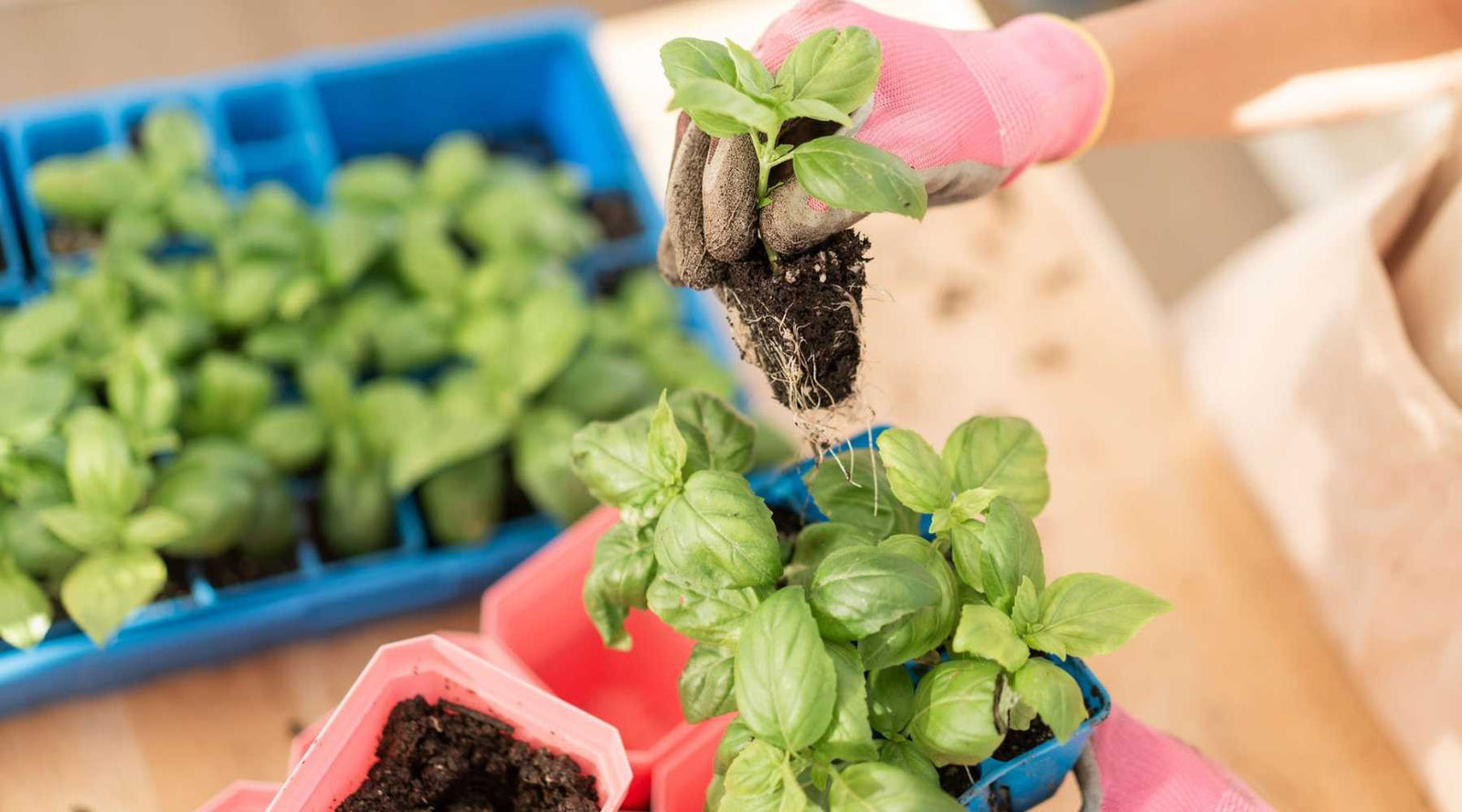
How up-potting can boost your garden's growth
Up-potting, sometimes called “potting up,” is the simple act of moving your seedlings into a slightly larger container. But don’t let its simplicity fool you, this one step can make a major impact on the health and productivity of your garden.
Whether you’re growing vegetables, herbs, or flowers, knowing when to up-pot and how to do it properly helps your plants develop stronger roots, avoid stress, and reach their full potential. In this guide, we’ll walk you through the why, when, and how of up-potting and help you choose the right tools to support every stage of your seedling’s growth.

Understanding Up-Potting: The What and Why
Every plant starts small, but not every plant thrives in the same container from seed to transplant. As seedlings grow, their roots need more room, and their access to nutrients changes. Up-potting is how gardeners respond to that growth.
When done at the right time, up-potting helps prevent root-bound plants, encourages steady development, and avoids the pitfalls of inconsistent watering. It also allows you to keep your seedlings growing indoors longer, giving them a better head start when it’s time to move them into the garden or greenhouse.
You'll notice benefits like:
-
More balanced growth above and below the soil
-
Stronger, more transplant-ready root systems
-
Better moisture and nutrient availability in fresh soil
This simple step of up-potting can be the difference between a seedling that ends up stunted and one that’s ready to take off the moment it is transplanted outdoors.
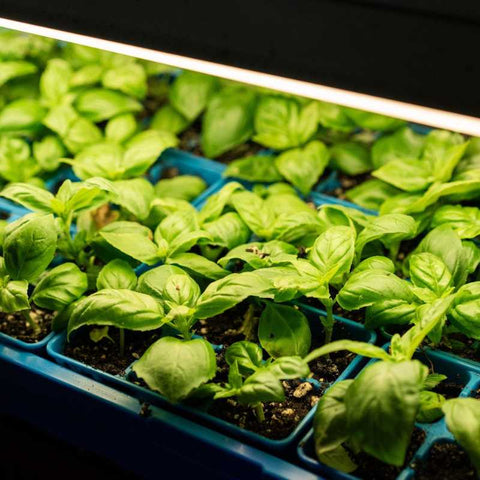
Signs Your Seedlings Are Ready to Move
So how do you know when it’s time to up-pot?
You might see roots starting to poke out the bottom of your trays or circling on the soil’s surface. Your plant might start drying out faster, growing more slowly, or appearing top-heavy and unstable. If it wilts even after watering, it could be root-bound and ready for more space.
Rather than relying on a checklist, observe how your plants behave. A healthy root system should hold the soil together when you gently lift the plant from the tray. If the plug falls apart or the roots form a tight spiral, it’s time to pot up.
When and Which Plants to Up-Pot
As seedlings grow, their roots expand in search of water and nutrients. When space runs out, your plant will start sending signals, sometimes subtle, sometimes obvious. You might notice that the soil dries out quickly, growth stalls or the plant begins to look top-heavy and unstable. Roots poking through the drainage holes or circling the soil surface are clear signs the container has become too small.
A plant that wilts even after watering or starts to lean and fall over is likely root-bound, meaning the roots have formed a tight network that’s limiting the plant’s access to moisture and nutrients. At this point, it needs to be either up-potted or transplanted to continue growing well.
However, not all plants mind being a little root-bound. Some houseplants such as peace lilies, spider plants, African violets, aloe, snake plants, and Boston ferns will actually bloom more or grow more densely when slightly crowded. But even these will eventually reach a point where their roots need more space or fresh soil to stay healthy.
Growth habit plays a role, too. Fast-growing vegetables like tomatoes, cucumbers, and squash often need to be up-potted multiple times before it’s warm enough to plant them outdoors. Slower growers like herbs, lettuce, and many perennial flowers may only need to be moved once. Long-term container plants, like fruit trees, shrubs, and indoor plants, will need occasional up-potting as they mature.

When to Up-Pot and When to Transplant
Not every plant you start indoors will need to be up-potted. If you’re able to transplant your seedlings into the ground or a large container before they outgrow their cells, you may be able to skip this step altogether.
But unpredictable weather, delays in garden prep, or staggered planting schedules often mean your seedlings spend more time indoors than expected. In those cases, up-potting becomes an essential part of your season plan.
Plants growing in air-prune trays can often wait a little longer since their root systems stay healthier and less tangled. But if you’re using standard cell trays or small nursery pots, expect to up-pot anything fast-growing, especially if it will be staying inside longer than 3–4 weeks.

Up-Pot Timeline (By Plant Type)
Timing your up-potting depends on how quickly a plant grows, how long it stays indoors, and how much root space it needs to thrive. Here’s a breakdown of common plant types and when you might expect to move them into larger containers:
Fast-Growing Vegetable Plants
Tomatoes, cucumbers, zucchini, and other vigorous growers often outgrow their starter trays in just a few weeks. If they aren't going straight into the ground, they typically need to be up-potted every 2–3 weeks.
Other veggies like beans, corn, carrots, radishes, and spinach can be started in smaller containers and moved up once they’ve developed their first few sets of leaves.
Lettuce, herbs, peppers, eggplant, and squash all benefit from up-potting, especially if you’re growing in limited space or using containers as your main garden.
Members of the cabbage family, including broccoli, cauliflower, and Brussels sprouts, do well when planted deeper in their new pots during the up-potting process, encouraging stronger stems and better structure.
Slow-Growing Plants
Succulents, bonsai, and other slower growers may not need to be moved more than once a year, or even every other year. They can tolerate tight quarters longer and usually signal their readiness through slowed growth or potting mix breakdown rather than visible root pressure.
Indoor Plants
Houseplants often need to be up-potted every 12–18 months, but that depends on both their container size and growth rate. A good clue? You’re watering more frequently than usual or seeing roots emerge from the bottom of the pot.
Perennials
Container-grown perennials can become root-bound over time. Most benefit from fresh soil and more space every 2–3 years, which helps rejuvenate growth and supports long-term health.
Trees and Shrubs
Smaller trees and shrubs usually need larger pots each year while they’re still gaining height. Once they reach your desired size, they can often stay in the same container with occasional top-dressing instead of full up-potting.
Orchids
While orchids like to be snug, they’ll need repotting every 1–2 years, mainly when the potting medium starts to break down. Even if roots are still contained, decomposed bark or moss can affect drainage and airflow.
As always, observe your specific plants closely. They’ll usually let you know when it’s time to make a move.
When to transplant seedlings outside
Transplanting tender seedlings outside is a regionally specific farm or garden task. However, in zones 8-11, you may be able to transplant seasonally appropriate plants all year round.
For colder growing zones, you may need to transplant your seedlings all at once in the late Spring once nighttime temperatures are reliably above 50℉. If you will be growing in a hoop house or cold frame you can move up your planting time by a number of weeks.
The best time to transplant any plant seedlings, whether it is one you have purchased from a local nursery or started yourself in seed starting trays, is once it has reached the proper stage of growth and outside conditions are appropriate.
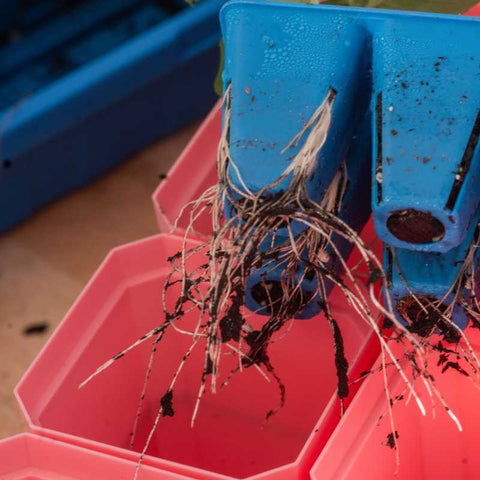
AT WHAT STAGE OF GROWTH DO YOU TRANSPLANT SEEDLINGS?
A common rule of thumb is to wait until your seedlings have developed their second set of true leaves before transplanting. But that’s just part of the picture.
What really matters is whether the seedling has built a strong enough root system to hold its shape when removed from the tray. If you try to transplant too early, the root ball may fall apart, damaging those delicate new roots and setting the plant back.
To check, gently grasp a seedling at the soil line and pull it from the tray:
-
If the entire plug slides out intact, the roots are ready.
-
If the plug falls apart, the plant needs more time.
-
If the plug comes out easily but shows dense, circling roots, it may already be root-bound and should be potted up or planted immediately.
Seedlings grown in trays like our cell trays need just the right balance: enough time to establish, but not so long that they start to outgrow the space.
Avoiding root-bound seedlings
When seedlings stay in small containers too long, their roots begin to circle the inside of the cell, eventually forming a dense, tangled mass. This is called being root-bound, and it can limit your plant’s ability to take up water and nutrients, even after transplanting.
One of the best ways to avoid root-bound seedlings is to start them in air-prune trays. Our 6-cell and 72-cell air prune trays are designed with side slits that expose roots to air, which naturally prunes them and prevents circling.
If you’re not sure when you’ll be able to transplant, these trays give you more flexibility and keep your root systems healthier for longer.
How to get seedlings with optimal root growth for transplanting.
The three best ways to achieve a healthy root system when growing your own plants from seed are:
- Use a bottom watering system to avoid compacting the soil.
- Plant in properly sized trays that encourage downward root growth.
- Pot up your seedlings before they become root-bound if you cannot transplant them yet.
For more information on growing your own plants from seed, check out our Seed Starting 101 Guide in the Seed Starting Resource Blog.
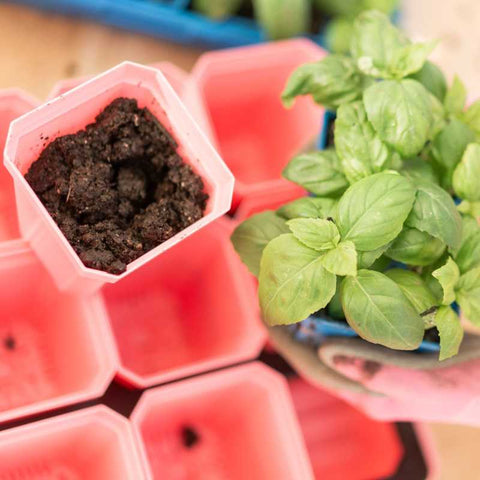
Up-Potting Tips and Procedure
Successfully up-potting plants involves several crucial steps. Here are some practical tips and best practices:
Choosing the Right Pot Size: The new pot should be just one size larger than the plant's current pot. Going too large can lead to overwatering, as the excess soil retains more water than the roots can absorb. Typically, choose a new pot that is 1-2 inches larger in diameter for small plants and 2-4 inches larger for bigger ones.
Selecting the Right Soil: The type of soil you use plays a significant role in your plant's health. Opt for a high-quality potting mix that suits your specific plant's needs. For most plants, general-purpose potting soil works well. However, some plants, like succulents and cacti, need a well-draining soil mix, while others, like ferns, prefer a more moisture-retaining blend.
Bootstrap tip: Always check the seed packet and seed provider’s website for additional crop and variety-specific information to help every aspect of your plant’s growth cycle.
Up-Potting Steps:
-
Water the Plant: Water the plant very lightly, a few hours before up-potting to reduce root stress.
- Remove the Plant: Gently guide the plant from its current pot, carefully not to damage the roots. If the plant is stuck, press the sides and bottom of the pot to free it, or use a popsicle stick or a Widger Dibbler Set to help pry the plants out.
- Prune the Roots: Examine the root ball. If you notice any dead or rotting roots, prune them off.
- Prepare the New Pot: Add some potting mix to the new pot and place the plant inside. The plant should sit at the same depth as in the previous pot. Fill around the plant with more soil, pressing gently to remove air pockets.
Bootstrap tip: Watering heavily 12-24 hours before transplant will help keep the soil intact while pulling out of the cells.
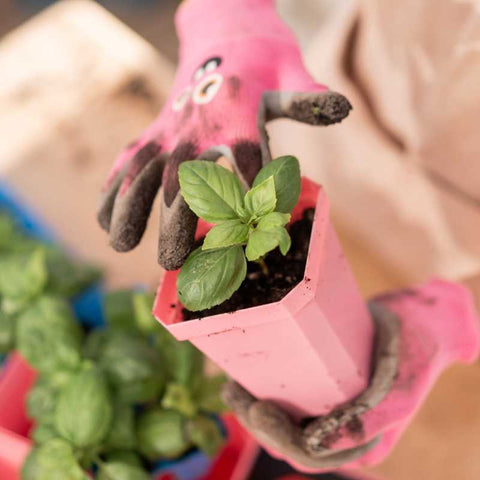
Aftercare for transplanted plants:
-
Water Thoroughly: After repotting, water the plant thoroughly to help the soil settle around the roots.
-
Provide Rest: Keep the plant in a quiet, shaded area for a few days after repotting to help it recover from the shock of being moved.
-
Monitor the Plant: Monitor your plant for a few days after repotting to check for signs of stress. Some wilting or leaf drop is normal, but prolonged symptoms could indicate a problem.
- Resume Care: Once the plant has settled into its new pot, resume your normal care routine.
How do I choose the best seedlings at the nursery?
When choosing seedlings from a nursery to transplant into your home garden there are a few things to look for to ensure you get the healthiest plant starts you can for a successful garden. You want big and healthy stems and leaves but not so big that the plant has overgrown its small pot and become root bound.
- Avoid leggy plants with tall thin stems. These have likely not been receiving direct sunlight and will possibly fall over when planted outside.
- Choose smaller, compact seedlings. They are ready to grow big once you plant them.
- Check the foliage for discoloration and damage. Leaves should be uniformly green (unless it is a plant with variegated foliage).
- Look at the underside of the leaves to be sure there are no hitchhiking pests like aphids or insect eggs.
- Check the plants for signs of disease, including yellowing of the leaves, brown spots, and dried-out tips.
- Look at the bottom drainage holes, a few visible roots are ok but if there are a lot sticking out through the holes it is probably root bound.
- Look for moss or signs of fuzzy mold on the soil surface. These are likely signs that the seedlings are old stock or of overwatering, both of which can cause weak transplants.
- Squeeze the sides of the pot. It should give a little under pressure showing that there is still some loose potting soil, meaning the roots have a little space left to grow into.
- Too little soil moisture is just as problematic as too much, so make sure the potting mix is moist but not sopping wet. Root-bound seedlings will often become hydrophobic and not properly take up water.
- Choose plants that have only leaves and possibly buds. Vegetables and fruits that have already begun to flower and fruit will stay small even if they are given more space.
Should I fertilize my seedlings before I plant them?
Most seedlings will grow just fine without additional feeding. In fact, too much nutrition in the growing medium can cause seedlings to be weak or prevent seeds from germinating. Using a balanced potting mix that contains some aged compost or worm castings will provide your plants with everything they need while they are small.
If you are using a sterile seed starting mix like ProMix that contains only coco coir, peat moss, or perlite to germinate your seeds, they may require a very light feeding once they have a second set of leaves. This only applies if you will be continuing to grow them indoors for a while beyond the second set of leaves.
We generally don't like to give direct advice about fertilizing as it is different for every individual and situation, but buying a well-rounded potting soil will help to ensure that your seedlings are covered nutritionally.
If you are planning on potting up tomatoes, peppers, cucumbers, or squash and have started them in a sterile seed starting mix, you can then pot them up into a larger container with a balanced potting soil. This is more effective than using garden soil, which may not have a balanced nutrient profile.
HOW LONG CAN SEEDLINGS STAY IN CELL TRAYS?
The length of time a seedling can stay in a cell tray depends on the size of the cells. Deeper and larger cells both allow for extended growth as the plant has more room. Seedlings otherwise can become root-bound if not given adequate space for the roots.
Typically, after sowing the seeds, the cell trays are used for around 3-4 weeks before transplanting occurs - whether it be to an outdoor plot or into a larger container. If transplanting tender seedlings outdoors, you may want to consider the use of a frost blanket to protect from late Spring frosts. Learn more about frost blanket in Frost Blanket: How to Use it and When.
One thing to keep in mind with transplants is to choose your sizing according to how long the transplant must stay indoors before getting transplanted into the garden. This will factor into Selecting the Right Cell Tray for the seed types you will be growing.

HOW DO YOU TRANSPLANT SMALL SEEDLINGS?
Farmers have moved into using cell trays in order to increase the amount of transplants that can be grown in a smaller space. Many have their own tips and tricks to finessing a seedling plug out of a cell or using a plug popper. Bootstrap Farmer cell trays are specially designed for growers by growers to make this chore a bit easier. Here's a great video highlighting how to remove the plugs from the cell trays.
Transplanting Seedlings Outdoors
The process of transplanting seedlings outdoors is very similar to up-potting. You are simply moving the plant into a larger space, just with the added variables of weather, soil, and sun. If you're planting directly into the ground or garden beds, start by hardening off your seedlings. This gradual introduction to outdoor conditions helps reduce transplant shock.
Once your planting area is prepped and your pots or beds are ready, make a hole just big enough for the seedling’s root ball.
One tried-and-true technique is often called the “slap-and-tickle” method. If your seedlings are in small pots, lightly slap the sides of the container to loosen the root ball. Then turn the pot upside down, support the base of the stem between your fingers, and give the bottom of the pot a few gentle taps until the plant releases into your hand. If the roots are circling or matted, tease them apart gently. This encourages outward growth in the new soil.
Set the seedling into its new hole, firm the soil around it lightly, and water thoroughly to help the roots settle in. If you’re dealing with full sun or wind, offer a little protection until the plant is established.
If your seedlings are in cell trays, the process is nearly the same, just with a different removal method. For trays with large drainage holes, press the plug up from the bottom. If the holes are small or the roots are clinging to the sides, use a dibbler or butter knife to gently loosen the plug before lifting it out.
Why plant seedlings over direct sowing seeds in the garden?
Sowing seeds into cell trays and planting starts into the ground offer some major advantages to the grower. You’ll be able to get a head start on the growing season by starting weeks before your last frost date. Planting into cell trays also helps increase the number of seedlings that can be grown in a smaller amount of space. This is a huge advantage for growers who are growing for quantity.
Another advantage of growing out seedlings to transplant is a higher seed success rate. You only transplant strong seedlings and, therefore, are generally able to have more growing success.
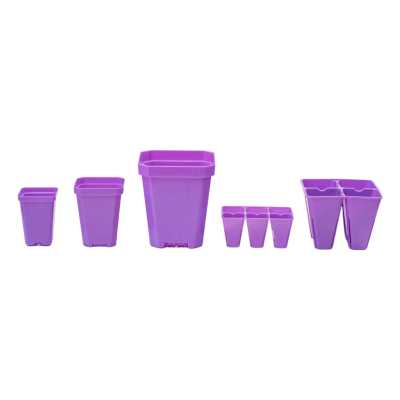
Bootstrap Farmer Up-Potting Equipment Options:
The Foundation: 1020 & 1010 Trays: Propagation trays for hobby or commercial growers are USA-made heavy-duty, making them easier to carry and move around.
Seed Starting Options: Bootstrap Farmer offers a complete lineup of options for gardeners based on industry-standard and Bootstrap Farmer innovations designed for farmers making a living from feeding their communities who need to depend on the equipment they invest in. All options are compatible with our 1020 & 1010 foundational trays and will move your seeds from first germination to field transplanting season after season.
Cell Trays: A cell tray insert is a plastic container with multiple individual compartments, each acting as a mini pot. These are typically used in seed starting and are designed to fit into Bootstrap Farmer 1020 trays. One of the key advantages of using cell trays is the efficient use of space. They allow gardeners to start many seeds within a small area, which is particularly beneficial for those with limited room. Furthermore, because each seedling is grown in its own cell, there is less disturbance to the roots when it's time to transplant. This reduces the risk of damaging the delicate seedlings during this crucial stage.
Additionally, having separate cells for each seed prevents overcrowding, which can lead to disease and poor growth. It also makes monitoring and managing each seedling's water, soil, and growth progress easier. Lastly, cell trays are reusable, providing a cost-effective solution for gardeners who regularly start seeds. Therefore, if you're considering starting seeds, a cell tray insert can be an invaluable tool to help ensure your seedlings enjoy the best possible start.
Bootstrap Farmer offers cell trays in 50, 72, 128, and 200-count cells.
Check out this article to learn more about Bootstrap Farmer cell trays and their use.
Air Prune Trays: An air prune tray for seed starting is a specially designed tray that encourages the development of a robust, fibrous root system in plants. The concept behind air pruning is that when a plant's root comes into contact with air at the edge of the potting medium, it naturally prunes itself and stops growing lengthwise. Instead, the plant focuses on producing new, lateral roots within the soil.
These trays often have open bottoms that expose the roots to air, triggering air-pruning. This design prevents the roots from circling the inside of the pot or becoming root-bound, which is a common problem in traditional pots.
Air prune trays promote healthier root development, leading to stronger, more vigorous plants. They are beneficial for seed starting as they help establish a robust root system early, setting the stage for successful plant growth.
Bootstrap Farmer offers 72-count trays, which are available in 6 colors. Black, orange, green, pink, blue, purple.
6-Cell Air Prune Trays: Our 6-cell tray inserts are made for the grower who wants an easily removable insert when growing various crops. These are not cheap seed tray inserts. They are built to be used for many years of use on farms. Available in our six Bootstrap Farmer colors, plus an additional five-color collection from Jill Ragan’s Whispering Willow 6-Cell Collection.
2.5” Pots: Our smallest pot is a gardener favorite, available in multi-color packs, black - or new this season, clear. Additional colors are available from Whispering Willow
They fit in our 32-cell plug trays, making planting your favorite vegetables, herbs, or flowers easier.
3.3” Pots: designed with the serious grower in mind., Eighteen of these pots are designed to fit in a 1020-deep tray (not included). Also available in sets with inserts and in multi-color.
4-Cell Air Prune Inserts: Need more options? Bootstrap Farmer larger 4-cell plug inserts are deeper for growing varieties of crops that need a little more room. Eight of these removable inserts fit in a Bootstrap Farmer 1020 tray. Made out of food-safe, heavy-duty polypropylene plastic and built to last many seasons. Color code your seedlings in these insert plug trays.
Available in black, blue, green, purple, pink, orange, and multi-color packs.
5-inch Nursery Pots: Designed with vegetable and flower gardeners in mind, these durable 5" pots are perfect for up-potting tender seedlings to plants already bearing fruit and flowers, giving northern growers more. Also available in sets with inserts in multi-color options.
Be sure to share your seed starting successes with us on Instagram and tag us with questions you have about the process.
Watch the Video
Also in How to Grow Seedlings
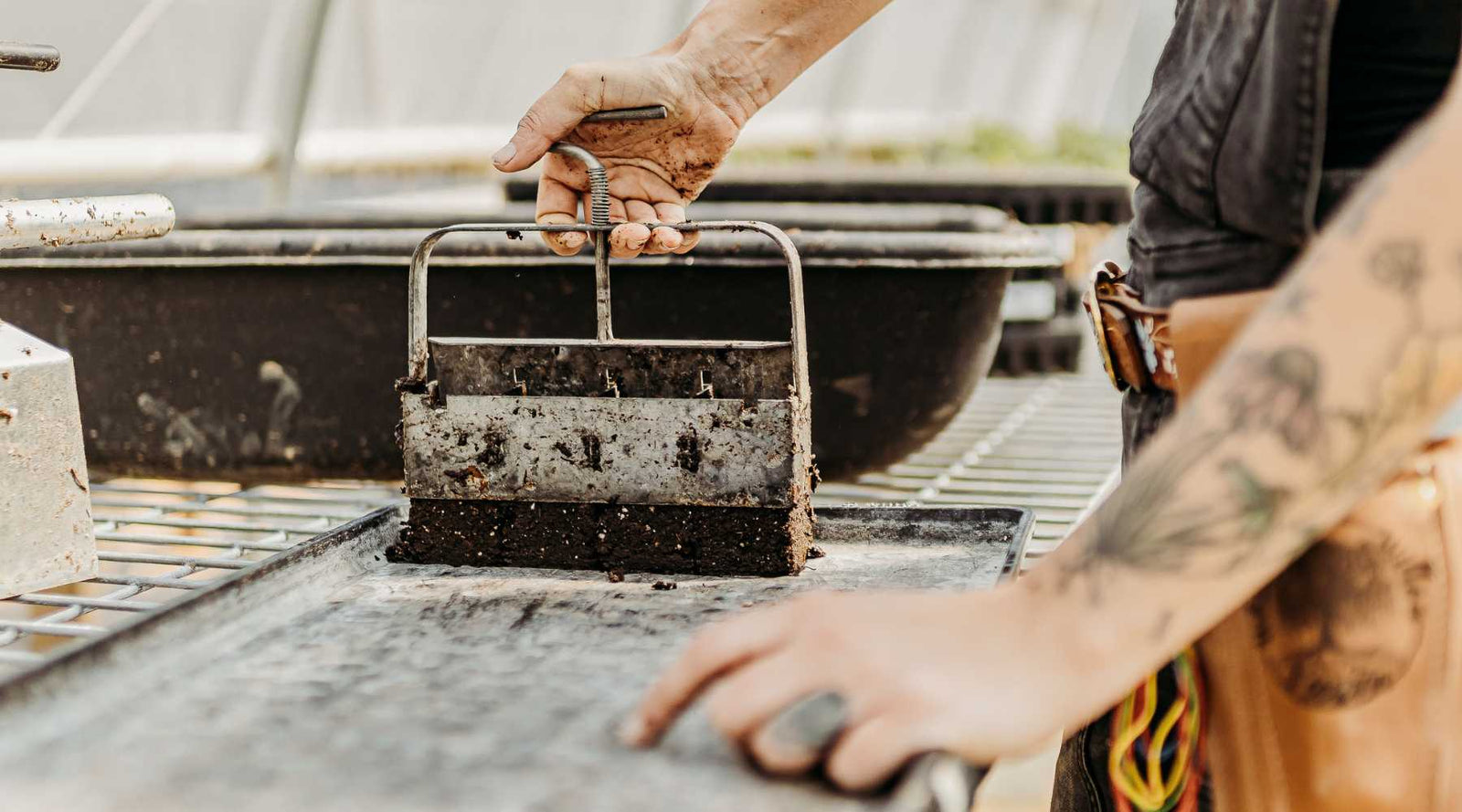
Soil Blocking 101
April 03, 2024 8 min read 0 Comments
Soil blocking is a method of propagating seedlings that involves filling a metal blocking tool with soil and squeezing to form a compressed cube. Seeds are planted directly into the formed block. Soil blocks come in various sizes and are advantageous for air pruning roots.

How to Use a Humidity Dome for Seed Starting
October 31, 2024 6 min read 0 Comments
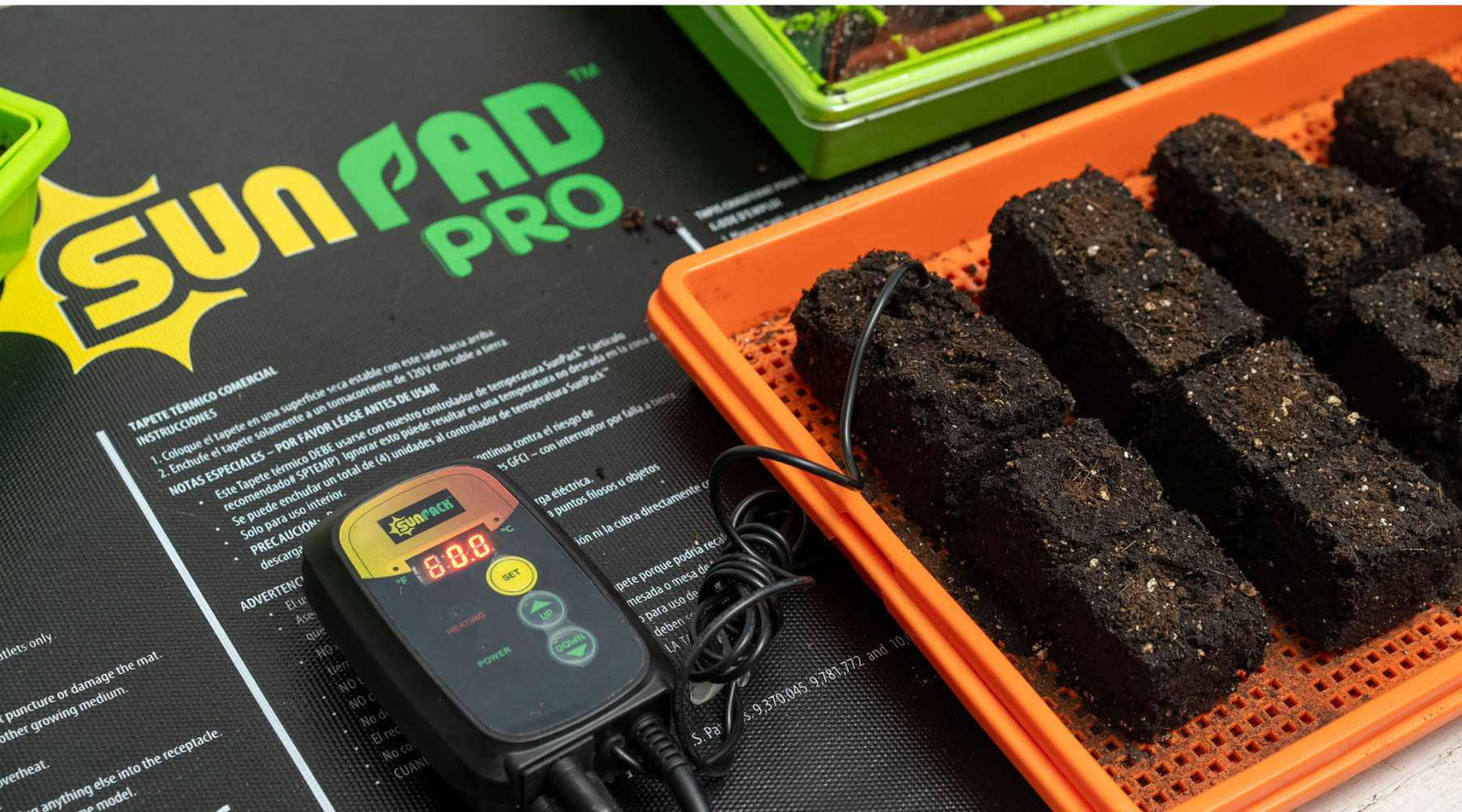
How to Use Heat Mats for Starting Seeds
March 07, 2025 11 min read 0 Comments
Recent Articles
- Soil Blocking 101
- How to Use a Humidity Dome for Seed Starting
- How to Use Heat Mats for Starting Seeds
- How to Transplant and Up Pot Seedlings
- Selecting the Right Seed Starting Cell Trays
- How to Wash and Care for Seedling Trays
- Seed Starting 101
- Hydroponic Growing Mediums: How to Plant into Rockwool Cubes
- How to Bottom Water Your Plants (Without Overdoing It) Step-by-Step
- Left with Extra Seed Starts? Try this.
Subscribe
Sign up to get the latest on sales, new releases and more …
